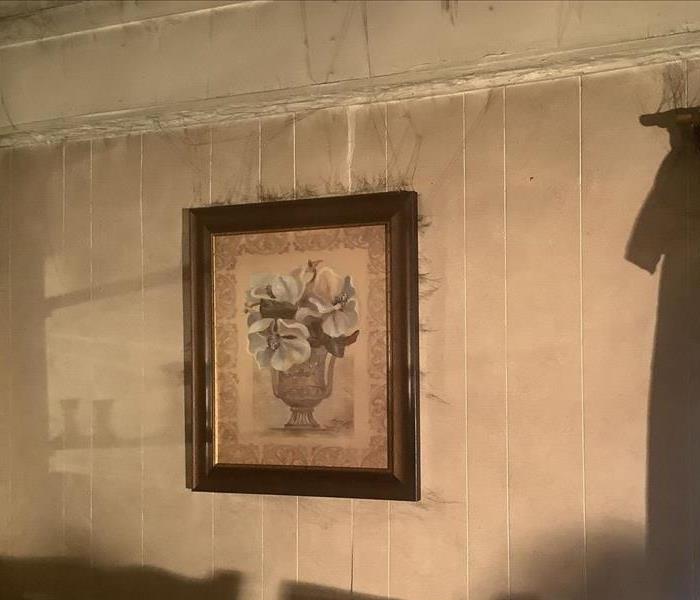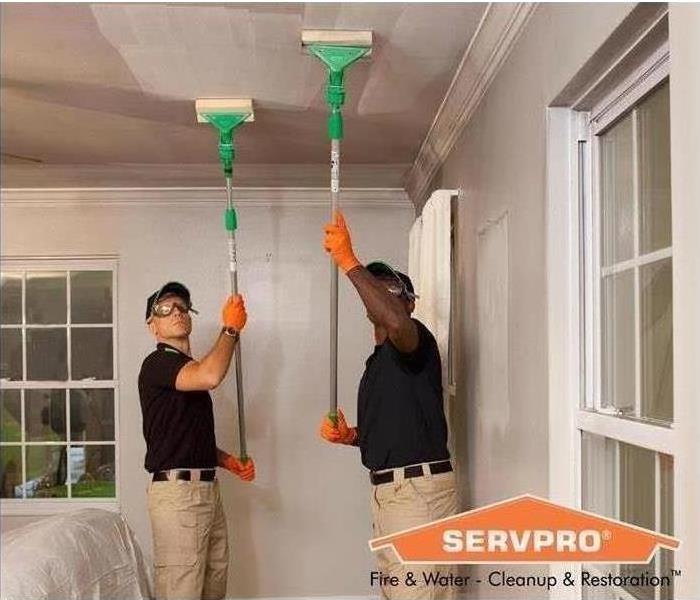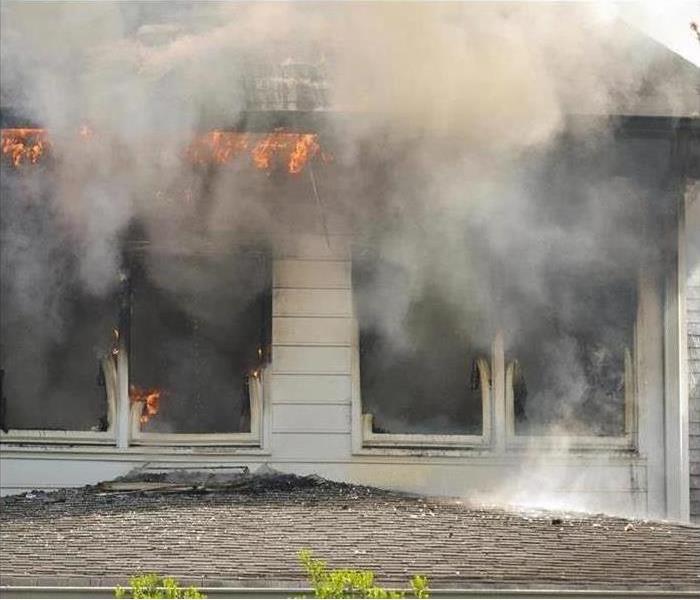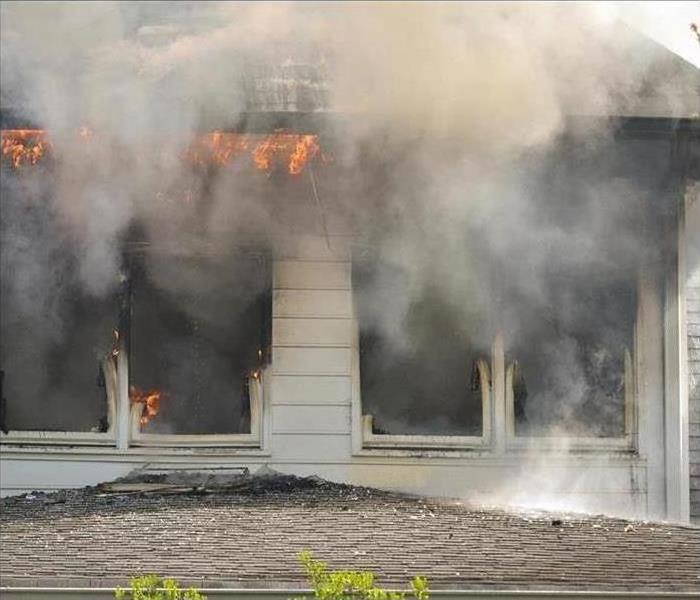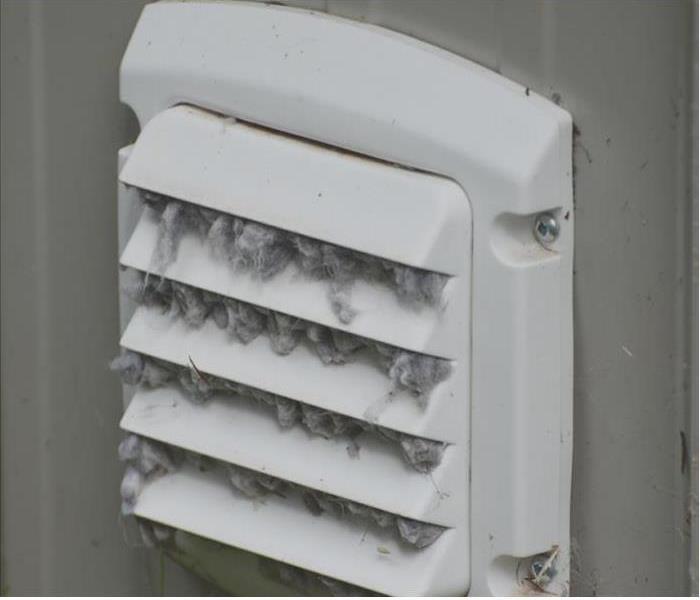Recent Fire Damage Posts
SERVPRO - Your experts in Fire Damage
3/1/2023 (Permalink)
When we visit your home after a fire loss, we will scope the affected areas to determine the extent of the loss. We will always pretest affected surfaces to determine the type of smoke and which products will help us recover the area most effectively. We have the equipment, expertise, and experience to restore your fire and smoke damage needs.
Smoke and soot facts:
- Hot smoke migrates to cooler areas and upper levels of a structure.
- The type of smoke may affect the restoration process.
- Smoke flows around plumbing systems, seeping through the holes used by pipes to go from floor to floor.
Different Types of Smoke
There are two different types of smoke–wet and dry. As a result, there are different types of soot residue after a fire. Before restoration begins, we will test the soot to determine which type of smoke damage occurred. The cleaning procedures will then be based on the information identified during pretesting.
Our Fire Damage Restoration Services
Since each smoke and fire damage situation is different, each job requires a unique solution tailored for the specific conditions. We have the equipment, expertise, and experience to restore your fire and smoke damage.
Smoke Webs
3/2/2022 (Permalink)
Did you know?
Residues (such as burning plastics or the soot from furnace disorders) form long chains of ionized smoke particles that assemble in corners or at junctions of walls and ceilings which are called smoke webs!
Does your business have a plan? Check out these tips:
Protect your people : Your employees are your most important business asset. These tips can help prevent them from being injured in a fire.
- Fire Plans: Make sure your employees know what to do if there's a fire, including calling 911 immediately. Conduct a fire drill at least once a year to keep employees aware of your workplace fire safety protocol.
- Evacuation Plan: In larger buildings, post a fire evacuation plan in several spots around the workplace. Never include elevators in an evacuation plan; always use the stairs.
- First Aid: In case of fire injuries, your employees should be familiar with the location of the first-aid kit, which should be kept where possible hazards can occur most-such as in the kitchen.
Fireplace Safety
2/14/2022 (Permalink)
- Fireplaces should not be used as furnaces. Use a fireplace for a short-duration fire — no longer than five hours.
- Keep the glass open to allow air to be drawn up to cool the chimney, but keep the screen closed to prevent sparks from jumping onto the carpeting.
- Never leave a fire unattended when children are in the house. Adults, even if near, should not allow children to play near or with fire tools and equipment.
- Open a window when using the fireplace to prevent the room from becoming smoky. The air coming in from the window will go up the chimney.
- Before making a fire, open the glass doors, pull aside the screen curtains, and place the kindling, newspaper and logs inside. Next, open the damper and a window. The window needs to be open only a few inches. You can check to make sure the smoke will go up the chimney properly by lighting a match, quickly blowing it out and watching the smoke to see whether it's going up and out.
- Keep a nonflammable rug (available at fireplace-supply stores) in front of the fireplace so that sparks won't melt or otherwise damage your carpeting.
- Use fireplace tools to handle burning logs. Never use your hands.
- Use a chimney cap to prevent water damage, to keep animals from nesting and to keep debris from blocking the chimney and causing carbon monoxide to flow into the house. Use a spark arrester to help prevent sparks from flying out, which could start a fire on the roof or lawn.
- Glass doors may develop tough stains from flames and heat. To clean them, make sure the glass doors are cool, then scrape off any thick gunk deposits with a razor blade. Add a squirt of liquid dishwashing detergent to a bucket of warm water, or add a cup of vinegar to a gallon of water. Spray or sponge the cleaner on, and then wipe it away with newspaper (which is lint-free). Another option is to buy glass cleaner at a fireplace store.
- Fireplace coals can remain hot enough to start a fire for up to three days, so always wait at least that long before removing the ashes. At that point, close the damper to prevent cold air in the flue from stirring up excess dust while you're removing the ashes. Be sure to wear a dust mask and open a window in the same room as the fireplace to prevent negative air pressure. Use a shovel to scoop the ashes into a metal container. Store the container far from combustible materials and surfaces and wood floors.
- Never use a vacuum to clean up ashes, because live coals may remain in those ashes.
- Have a certified chimney sweep inspect and clean the chimney when necessary. Have him show you how to check it yourself, too. The chimney should be checked at least once a year or after about 80 fires.
- Shine brass fireplace utensils with Worcestershire sauce and a toothbrush.
- Clean the firebox (the area where the logs burn) at least once a week during the months you use it, when ash builds up. Leave about an inch of ash because it acts as insulation, allowing the coals to heat faster and retain the heat easier. Keep the firebox completely clean during the months when the fireplace is not in use.
- To clean an exterior slate hearth, wash, dry and coat it with lemon oil every six weeks to make it shine. For cleaning exterior brick hearths, buy a brick cleaner at a fireplace shop.
via HGTV.com
Helpful Tips for Fire Damages
2/9/2022 (Permalink)
After any fire damage situation, your primary focus should be safety first:
- Is it safe to stay in the house?
- Electrical and "slip and fall" hazards are some of the most prevalent concerns.
- Only do activities that are safe for you to perform.
- Wet materials can be VERY heavy. Be careful!
Have Smoke or Fire Damage? Call SERVPRO today at (662) 289-7473
What To Do After A Fire
- Limit movement in the home to prevent soot particles from being embedded into upholstery and carpets.
- Keep hands clean so as not to further soil upholstery, walls and woodwork.
- Place clean towels or old linens on rugs, upholstery and carpet traffic areas.
- If electricity is off, empty freezer and refrigerator and prop doors open.
- Clean and protect chrome with light coating of petroleum jelly or oil.
- Wash houseplants on both sides of leaves.
- Change HVAC filter.
- Tape double layers of cheesecloth over air registers.
What NOT To Do After A Fire
- Don't attempt to wash any walls or painted surfaces or shampoo carpet or upholstery without contacting us.
- Don't attempt to clean any electrical appliances that may have been close to fire, heat or water without consulting an authorized repair service.
- Don't use any canned or packaged food or beverages that may have been stored near the fire, heat or water.
- Don't turn on ceiling fixtures if ceiling is wet. The wiring may be damaged.
- Don't send garments to an ordinary dry cleaner. Improper cleaning may set smoke odor.
Once The Fire Is Out Who Will Help Put The Pieces Back Together??
2/6/2022 (Permalink)
The leading causes of fire in a home include:
- Cooking
- Heating Units
- Electrical
- Smoking
No matter how the fire started, a rush of emotions and feelings of panic seem to follow. After calling the Fire Department to put out the fire, who do you call to help you clean up the damage caused by the fire?
SERVPRO professionals are trained in the cleanup and care of your home and personal belongings following a fire incident. Before attempting to clean up the fire damage yourself, call us at SERVPRO of NEDL at (662) 289 - 7473.
What to do After a Fire
2/1/2022 (Permalink)
Have you had a fire in your home? "Devastating" is an understatement when experiencing the chaos of a fire in your home. Not only is it difficult to deal with the loss, but the clean-up can be, too. If it is a small isolated fire, getting the area cleaned and repaired should be a priority! The first thing to consider is the ash and smoke damage. These can lead to corrosion, unpleasant odor, and discoloration. Getting ash and smoke cleaned up immediately will prevent any of these from leading to an even larger problem. Take immediate action by following these steps if you find yourself handling the aftermath of a house fire: 1. Contact your insurance company. 2. Contact your local fire restoration company. 3. Take photographs of the damage. 4. Keep a record of all conversations with your insurance company. 5. Make a list of everything you lost or that was destroyed. 6. Find a place to stay while your restoration company cleans up your property. While a house fire is a difficult experience, it helps to have a game plan in place. So remember these steps for the next time you or someone you know is handling the aftermath of a house fire, and call SERVPRO.
Once The Fire Is Out Who Will Help Put The Pieces Back Together??
2/1/2022 (Permalink)
The leading causes of fire in a home include:
- Cooking
- Heating Units
- Electrical
- Smoking
No matter how the fire started, a rush of emotions and feelings of panic seem to follow. After calling the Fire Department to put out the fire, who do you call to help you clean up the damage caused by the fire?
SERVPRO professionals are trained in the cleanup and care of your home and personal belongings following a fire incident. Before attempting to clean up the fire damage yourself, call us at SERVPRO of NEDL at (662) 289 - 7473.
Fire Tips for Kids
2/14/2021 (Permalink)
According to the American Burn Association, children are the most susceptible to burn injuries. 73% of all burn injuries happen in the home. At some point in time, children are going to be curious about fire, but it can be dangerous and costly.
Here are some tips to follow to keep your family safe according to the National Protection Association:
- Be sure to keep all matches and lighters out of the reach of children, preferably somewhere up high or in a locked cabinet.
- Closely supervise your children, making sure that they are away from any fire sources, including lit candles, cigarettes, fire pits, and stoves.
- Take advantage of any opportunity to teach your children about fire safety.
- Explain that fires are something to be taken seriously as they move very fast and can hurt you with contact.
- Teach young children to not touch matches or lighters, and to notify an adult immediately if found.
- Establish a clear set of rules and consequences about unsupervised and unapproved uses of fire.
- Remember, children are always watching. Make sure you set a good example by handling fire in a safe manner.
- Show your children appreciation for displaying respect and age-appropriate responsibility when it comes to fire.
If your children happen to burn themselves, cool the burn by running it under cold water for 10 to 15 minutes.
If it is a more serious burn, CALL 9-1-1.
3 Tips for Cleaning Your Dryer Vent
2/9/2021 (Permalink)
Fires at your home might happen for a number of reasons, and one cause you may overlook is your dryer’s vent. A lint fire can spread quickly and create a large blaze that can cause serious damage throughout your property. You could reduce this risk by learning how and when to clean out your dryer vent and how to practice dryer safety that can keep your home and family safe.
1. Clean the Vent Bi-Annually
Cleaning your dryer vent out twice a year, in the spring and in the fall, can clear out lint buildup that can cause a serious fire and help you discover any other problems that may increase the risk. Consider making this task a regular item on your spring or fall cleaning list so you do not forget.
2. Clean Each Part Thoroughly
A lint fire can start when the heat from the dryer causes trapped lint to ignite. Lint often builds up in the trap, hose, and vent ducts, so be sure to clean each part with a vacuum cleaner. Start with the lint trap, then unplug the dryer and vacuum all around the house before disconnecting it. Shake out the trapped lint and then clean out the duct. Plug the machine back in and then vacuum up any remaining debris that could cause a dryer fire.
3. Have Your Dryer Area Inspected
Calling in a fire damage and restoration service to ensure your dryer space is properly protected may reduce the chance of a fire. Whether your laundry room is inside your home or in a semi-detached space, restoration technicians can help you understand whether the space is safe and how you might prevent future fires, such as cleaning the dryer’s lint trap after each use and disposing of lint away from the dryer.
You can prevent a lint fire at your home with proper dryer maintenance and cleaning. You can teach your family these tips as well so they can help you keep your home safe from sudden fires.
4 Rules to Prevent Kitchen Fires
2/7/2021 (Permalink)
While fire remediation companies are available to help you rebuild your home, the preferable option is likely to avoid a fire. While wishful thinking will not always prevent a disaster from happening, when it comes to kitchen fires, you can follow four tips to limit the possibility of a grease fire.
- Stay alert
- Remain present
- Use a timer
- Remove flammable items
Stay Alert
Kitchen fires and damage often occur because someone lets their guard down while cooking. It is easy to become distracted, especially when dealing with complicated recipes that involve long periods of cooking. However, it is vital that you stay alert. Therefore, if you are drowsy or have had a few drinks, then it might be a good idea to hold off making that fancy meal.
Remain Present
When it comes to kitchen fire prevention tips, the best one is to remain present. You can take this literally. Do not leave the kitchen when you have things frying on the stove. If you must leave, then find someone willing and able to watch the meal for you while you are away. Kitchen fires can happen in an instant, and they require quick responses to limit potential damage.
Use a Timer
If no one is home and you absolutely must leave the kitchen, then set a timer. It is easy to become distracted with other chores. A timer will bring your attention back to the kitchen, where it ultimately belongs.
Remove Flammable Items
Before cooking anything on the stovetop, make sure that you remove any potentially flammable items. For example, move cloth oven mitts and any boxed or plastic objects. You need the workspace to be clear of any fire risks.
The four tips above will help to reduce your risks of a kitchen fire. However, keep in mind that fire is dangerous, and if something your cooking does ignite and you can't extinguish it, get to safety and call 911.
Fire Restoration
2/2/2021 (Permalink)
SERVPRO of Northeast Delta Lands responded to a lightening fire loss in Grenada where the whole house was affected with soot & smoke. Our crews performed the cleaning of the structure, the demolition, the pack out of contents and the cleaning of the contents, disposed of the unsalvageable items.
No one expects a fire to happen to them, and therefore they frequently are unprepared for what they must do to help return their lives back to normal. Our disaster restoration experts will be there to help you clean up and restore your home or business to its preloss condition.
Our certified team of professionals are trained and specialized to handle large and small fires and smoke damage cleanup. When disaster strikes, SERVPRO of Northeast Delta Lands has you covered!
Have Questions about Fire, Smoke, or Soot Damage?
Call Us Today – 662-289-7473 We are Here to Help!
Home Fire Pit Tips
1/26/2021 (Permalink)
Here in Kosciusko, MS its a tradition to enjoy the cooler nights outside around a homemade fire pit! Many of us are looking forward to spending time gathering around them to enjoy time with family and friends. Before you start dreaming of moonlit nights and toasted marshmallows, take a moment to check out some of these tips from Allstate to remember.
Backyard Fire Pit Safety Tips:
- Whether you prefer a built-in or portable fire pit, choose one that is not too large for the area. The pit should be a minimum of 10 feet away from any structures or combustible materials as well as away from trees, fences, sheds, power lines, and telephone wires.
- Make sure that the seating area is large enough and properly placed for comfort and ventilation.
- Check wind direction before lighting a fire.
- Don’t use flammable fluids (gasoline, lighter fluid, etc.) to light or relight fires.
- To start the fire, use a lighter to ignite crumpled pieces of paper covered with small sticks. Then, add larger sticks and a log or two to keep it burning.
- Burn only dry material. Damp material will create excess smoke.
- Don’t wear flammable clothing (like nylon) or any loose-fitting clothing.
- Never leave the fire unattended, and keep pets and children far away from the fire as they will be attracted to it.
- Keep a fire extinguisher, garden hose, or bucket of water nearby.
- As the fire dies down, use a shovel and spread out the ashes to allow them to cool down. Then slowly pour water over those ashes and watch them closely to be sure that no burning embers remain or reignite. Put the cooled ashes in a specially designated ash storage metal can.
Electrical Fire at Middle School
1/26/2021 (Permalink)
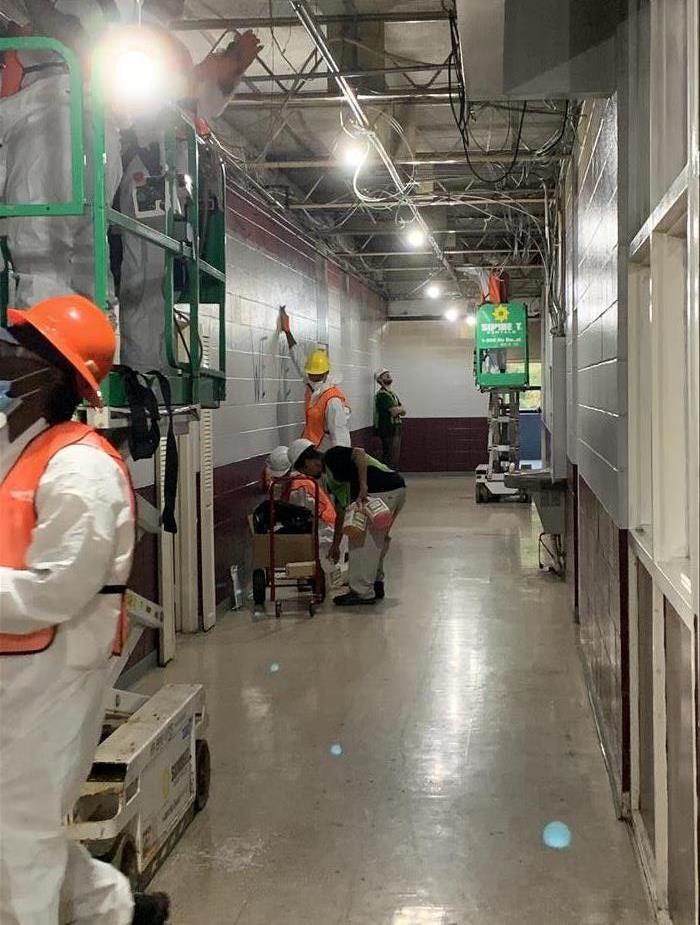 Multiple SERVPRO team members working I hallway at the middle school.
Multiple SERVPRO team members working I hallway at the middle school.
On average, 24000 electrical fires occur in the U.S. per year, according to the U.S. Fire Administration.
Electrical issues caused this certain fire at a middle school here in Kosciusko.
SERVPRO of Northeast Delta Lands and SERVPRO of Columbus/Starkville were happy to be of assistance!
Thankfully this fire happened after hours so no children or staff were present. Damage was severe in some areas, but only soot and odor in other areas. The entire school was cleaned and School was able to resume in January.
SERVPRO Tip:
Remember especially this time of year space heaters are a top cause of electrical fires. Heaters are often left on in front of/on combustible surfaces like curtains and rugs. Coil heaters are the most dangerous.
Fire Damage Tips
2/6/2020 (Permalink)
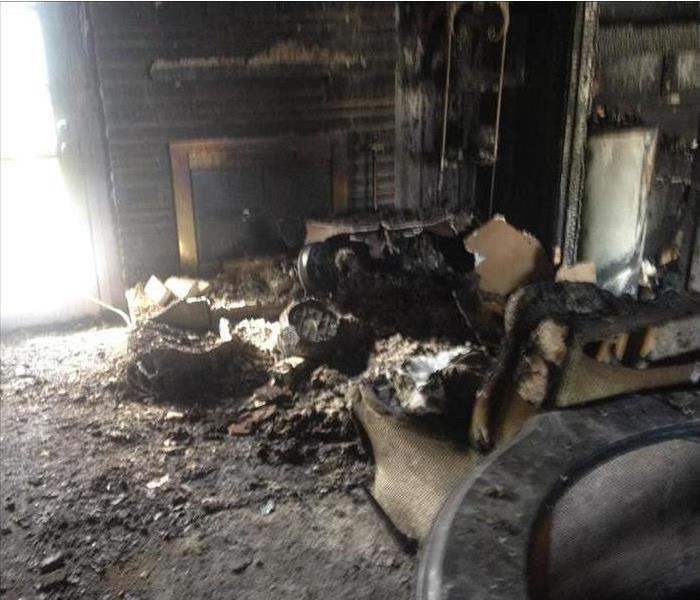 A fire can cause damage to thing you may not even see or think! It can be a dangerous situation after all flames have been put out.
A fire can cause damage to thing you may not even see or think! It can be a dangerous situation after all flames have been put out.
After any fire damage situation, your primary focus should be safety first:
- Is it safe to stay in the house?
- Electrical and "slip and fall" hazards are some of the most prevalent concerns.
- Only do activities that are safe for you to perform.
- Wet materials can be VERY heavy. Be careful!
Have Smoke or Fire Damage? Call SERVPRO of Northeast Delta Lands at (662) 289-7473
What To Do After A Fire
- Limit movement in the home to prevent soot particles from being embedded into upholstery and carpets.
- Keep hands clean so as not to further soil upholstery, walls and woodwork.
- Place clean towels or old linens on rugs, upholstery and carpet traffic areas.
- If electricity is off, empty freezer and refrigerator and prop doors open.
- Clean and protect chrome with light coating of petroleum jelly or oil.
- Wash houseplants on both sides of leaves.
- Change HVAC filter.
- Tape double layers of cheesecloth over air registers.
What NOT To Do After A Fire
- Don't attempt to wash any walls or painted surfaces or shampoo carpet or upholstery without contacting us.
- Don't attempt to clean any electrical appliances that may have been close to fire, heat or water without consulting an authorized repair service.
- Don't use any canned or packaged food or beverages that may have been stored near the fire, heat or water.
- Don't turn on ceiling fixtures if ceiling is wet. The wiring may be damaged.
- Don't send garments to an ordinary dry cleaner. Improper cleaning may set smoke odor.
The Fire Restoration Process
2/6/2020 (Permalink)
Fire damage is probably the last thing on your mind, but you may want to move it up on your list of priorities; preparation is the key. The first 48 hours after a fire often makes the difference between ‘restoring’ vs. ‘replacing’ your property and personal belongings. SERVPRO of Northeast Delta Lands provides a timely response with mitigation services ranging from fire, smoke and soot removal, to content claims inventory and document restoration.
Here is a timeline to help ease your mind of what should be done before and after SERVPRO of Northeast Delta Lands arrives:
One Hour
Within one hour from notice of loss, a SERVPRO of Northeast Delta Lands professional will contact you to arrange for service.
Four Hours
Within four hours of loss notification, a SERVPRO of Northeast Delta Lands technician will be onsite to start mitigation services.
Detailed Explanation
A trained and uniformed SERVPRO of Northeast Delta Lands employee will walk you through the job process step-by-step, explaining what to expect and the anticipated outcome.
Pretesting
A SERVPRO of Northeast Delta Lands employee will begin pretesting for restoration, working from the source of the damage outward.
Eight Hours
Within eight business hours of on-site arrival, a verbal briefing of the scope is communicated to the appropriate person.
Cleaning, Restoration, & Deodorization
SERVPRO of Northeast Delta Lands will work neatly and efficiently to help you regain control of your property. We then use state-of-the-art restoration techniques to make it “Like it never even happened.”
Final Walk-through
After the work has been completed, a final walk-through will be conducted with you to help ensure your satisfaction. SERVPRO of Northeast Delta Lands responds quickly, offering a full line of fire cleanup and restoration services to help you return home as soon as possible. Before risking further damage by attempting to clean up the damage on your own, call the fire damage clean up and restoration professionals. Call us, (662)289-7473
Facts about Smoke and Soot
12/18/2019 (Permalink)
Smoke and Soot Damage can cause a long-lasting odor in your home
Smoke and soot can cause hidden damage and odor. Our Production Techs are experts when it comes to smoke damage who can accurately assess the extent of the damage to develop a plan of action. Facts about Smoke and Soot
- Hot smoke migrates to cooler areas and upper levels of a structure.
- Smoke flows around plumbing systems, seeping through the holes used by pipes to go from floor to floor.
- The type of smoke may greatly affect the restoration process.
Different Types of Smoke Did you know there are actually different types of smoke? There is what is called wet smoke and dry smoke! Check out the two types below in more detail. Wet Smoke // Plastic and Rubber
- Low heat, smoldering, pungent odor, sticky, smeary. Smoke webs are more difficult to clean.
Dry Smoke // Paper and Wood
- Fast burning, high temperatures, heat rises, therefore, smoke rises.
Protein Fire Residue // Produced by evaporation of material rather than from a fire
- Virtually invisible, discolors paints and varnishes, extreme pungent odor.
Fire Safety for Pets
12/18/2019 (Permalink)
Pets can be considered family, too!
At any given moment, a fire emergency can take place in the North Houston area or abroad, and though unexpected; it can be beneficial to already have a plan in place for everyone in your home to evacuate and meet in a safe location. While you should always be most focused on keeping yourself and your family safe, you can also spend some time on pet preparation so that you can have a better chance of getting your pets out of danger as well. You can be better prepared to keep your pets safe during a fire emergency by following these safety tips:Practice Evacuating
In the confusion caused by a fire, it can be hard to think of everything you need to do right away. If you have a plan in place and practice it a few times, you can be better prepared to handle a fire emergency. This can not only be helpful for pet safety, but also for the safety of everyone in your household. Notice Where Your Pets Are
An important part of the planning process can be noticing where your pets usually spend their time. It can be especially helpful to note where they hide when frightened. You don’t want to put yourself at risk by spending too much time searching for your dog or cat during a fire emergency, but you can be better prepared to get yourself and your pets out as soon as possible by having a checklist of areas you can look. Keep Collars and Leashes Handy
Fires can be especially frightening to pets. By keeping their collars and leashes handy, you can more easily guide them out of the house. If you are unable to find them, it can be easier for the fire department to get them out if they are wearing collars. It can be a good idea to hang leashes by the door you are planning to evacuate through. Call us at 662.289.7473.
Fire Extinguisher 101
10/8/2019 (Permalink)
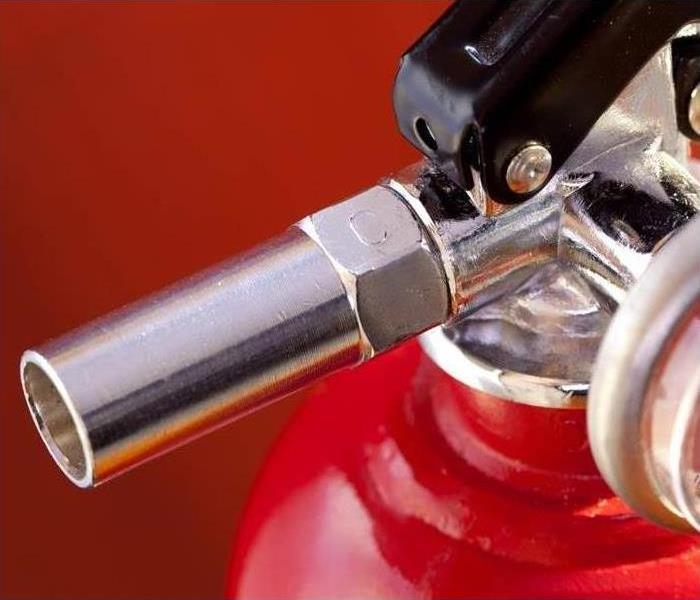 Always be prepared. SERVPRO of Northeast Delta Lands is her to help
Always be prepared. SERVPRO of Northeast Delta Lands is her to help
Ensuring your home has at least one working fire extinguisher is one of the first steps toward fire preparedness. However, these important tools can come in a variety of styles. Here are a few tips for choosing the right extinguisher for your home.
1. Consider the Chemical Rating
Many extinguishers include an A, B or C rating to help you know which home fire type it is rated for. The A rating is used for dry combustible materials such as paper or wood, while the B rating indicates effectiveness against flammable liquids. Both of these ratings should have a number after the letter. These numbers indicate the effectiveness level with higher numbers being more effective than lower. The C rating indicates that the extinguisher materials are non-conductive, and may be used in the event of an electrical fire. There is no numeral indicator for C ratings.
2. Look at the Valve Type
There are two types of valves your fire extinguisher may come with. A plastic valve indicates the extinguisher is disposable and will need to be replaced after time or after being used. A metal valve is used for refilling the tank when the pressure gets low over an extended period of time, or after use. Most extinguishers include a gauge to help you determine when a refill may be necessary.
3. Keep the Size in Mind
Extinguishers can come in a variety of sizes. The size you choose may depend on the location it is intended for. Large extinguishers should be kept in areas where a fire may grow quickly, while small to medium extinguishers are best for quick grab situations. In all cases you should know how to properly use your fire extinguisher and follow proper fire safety protocols.
Whatever type of fire extinguisher you choose, remember to read the instructions for its use. It’s also important to keep your extinguisher in working order by checking the pressure and age readings, and having your extinguisher refilled or replaced when needed.
Keep Fall Fire Free
10/8/2019 (Permalink)
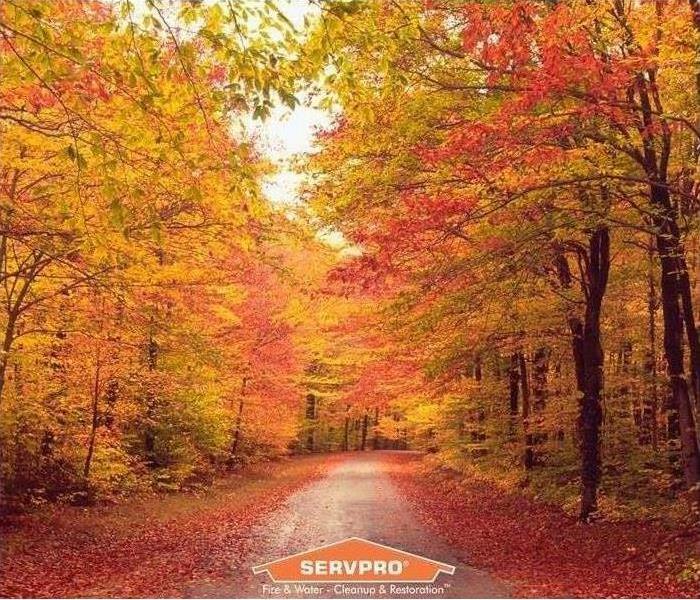 SERVPRO of Northeast Delta Lands is here to hlep 24/7. Call us whatever your fire, mold or water needs may be. 662-289-7473.
SERVPRO of Northeast Delta Lands is here to hlep 24/7. Call us whatever your fire, mold or water needs may be. 662-289-7473.
The fall season brings cooler temperatures, beautiful colors, and an abundance of outdoor activities. But the season also brings many fire risks. Plan ahead this season to help ensure it is safe and fire-free.
Decorations
Fall decorations, like dried flowers, leaves and cornstalks, are highly flammable. Keep these and other decorations away from open flames and heat sources, including light bulbs and heaters. Since these items are dry, they can ignite very easily and spread flames quickly.
Have A Plan
Be sure you have a Fire Preparedness Plan and your family knows what to do if a fire breaks out in your home. Keep emergency exits clear of decorations so nothing blocks escape routes.
Protect your family by teaching your children to stay away from open flames. Be sure they know how to stop, drop, and roll if their clothing catches fire.
Ensure your smoke alarms are in working order and that you have an easily accessible fire extinguisher.
Make Halloween Safe
Remember safety first when choosing a Halloween costume. Consider avoiding billowing fabrics. If you are making your costume, choose material that won’t easily ignite if it comes into contact with heat or a flame.
It is safest to use a flashlight or battery-operated candle in a jack-o-lantern. Use extreme caution if using a real candle. Place lit pumpkins away from anything that can burn, and out of the way of doorsteps, walkways, and yards.
Be Careful in the Kitchen
With the holidays quickly approaching, your kitchen may be working on overdrive. While cooking, it can be easy to get distracted, especially if you have children. However, kitchens are a high-risk area for household fires, so it’s important to remain watchful.
Never leave food unattended while cooking, especially working with oil. Hot grease can splash and ignite. Keep flammable objects, like washcloths, potholders, and paper towels, away from the stovetop.
If a fire starts in your oven, keep the door closed. Turn it off and wait for the fire to extinguish.
Safely Use Your Fireplace
As the weather turns cold and brisk,fireplaces can bring a warm and inviting atmosphere to any home. However, if fireplaces are not properly cared for, they can lead to an increased fire and smoke risk. Make sure your fireplace is clean and well maintained and never left unattended when lit.
Fire Preparedness
8/23/2018 (Permalink)
Fires at your home or business can be a very difficult and stressful experience. In most cases the fire starts without notice. Each year more than 2,500 people die and 12,600 are injured in home fires in the United States. This number could drop significantly if we would prepare for the worst and hope for the best. A big problem that we see, is that the average person has the attitude that it will never happen to them. Which is the worst attitude to have when it comes to any form of disaster. Here at SERVPRO of Northeast Delta Lands we urge the people in our community to prep homes and businesses for any types of unannounced disasters, especially fires. They come on quickly, with hardly any warning and can destroy everything if not properly put out by your local fire department. Here at SERVPRO of Northeast Delta Lands we strive to make it "Like it never even happened."
Smoke and Soot
8/23/2018 (Permalink)
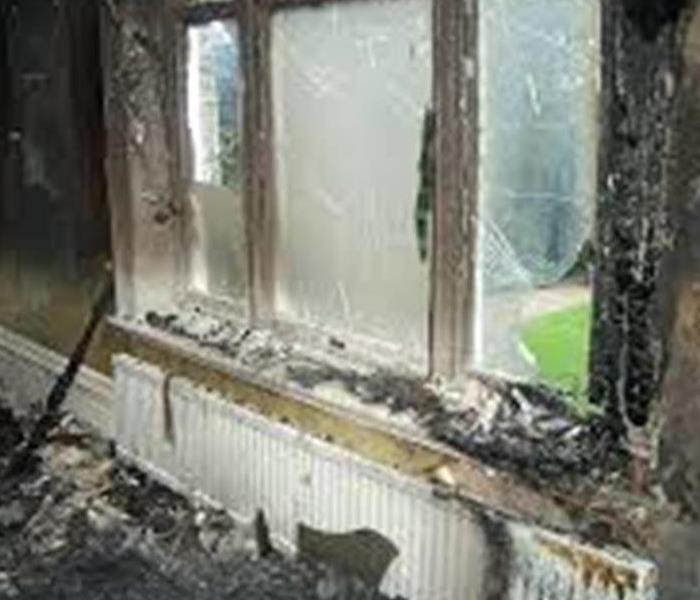
You've just suffered a fire and you decide you want to save a few bucks on the restoration process and handle the cleanup yourself. Smoke and soot are a reminder of the disastrous fire that took its toll on your home. Left over smoke and soot following a fire can be unsightly and foul smelling. Fire damage can linger for years unless properly addressed and restored correctly. Adequate safety equipment is essential in reducing possible dangers to smoke and soot exposure and other health related issues resulting from the firefighting efforts. Proper ventilation is also necessary to protect and restore indoor air quality following a fire. HEPA filtration can absorb toxic air flow in the house and is used to preserve air quality as well. If you have any concerns or questions, we urge you to contact your local SERVPRO of Northeast Delta Lands, where the experts and professionals can assist you with any type of destruction, including smoke and fire damage. It’s a pledge that SERVPRO makes to its community.
First Responders
5/18/2018 (Permalink)
We had to opportunity to partner with a local State Farm insurance agency and take time out to say a big thank you to the First Responders in Philadelphia Mississippi. We had a cookout where we had hamburgers, sausage dogs and all the trimmings. We could not have planned a better day for the event, mid 70’s temperature and not a cloud in the sky. It was good to see all the local responders coming out and enjoy the food, sunshine and great conversation. We had a great turn out and there was representation from the Philadelphia Police Department, Neshoba County Sheriff's Department, Choctaw Police Department, we had several city and Volunteer firemen along with several Emergency Medical Technicians drop in for the event. While we can truly never repay them for what they do on a day to day basis, we do want again to say Thank You for all you do for the community.
American Red Cross Home Fire Campaign
5/3/2018 (Permalink)
Each year, the Red Cross responds to nearly 64,000 disasters, the vast majority of which are home fires. So we set a goal to reduce fire-related deaths and injuries in the US by 25%.
On average:
- 7 people die every day from a home fire, most impacting children and the elderly
- 36 people suffer injuries as a result of home fires every day
- Over $7 billion in property damage occurs every year
Every day, seven people die in home fires, most in homes that lack working smoke alarms. Sadly, children and the elderly disproportionately lose their lives. The American Red Cross wants to improve the odds and save lives- that’s why we launched our Home Fire Campaign in 2014.
A critical part of the campaign is Sound the Alarm, a series of home fire safety and smoke alarm installation events across the country. Together with fire departments and other community partners, Red Cross volunteers:
- Canvass at-risk neighborhoods
- Install free smoke alarms
- Replace batteries in existing alarms
- Provide fire prevention and safety education
In just three years, our home visits have accomplished so much, including the installation of more than 1 million smoke alarms and preparing more than 1 million people against home fires.
Join us April 28 through May 13 on a Sound the Alarm home visit in your community, where teams of volunteers will be installing 100,000 free smoke alarms in more than 100 cities across the U.S. Together, we can save lives!
Check out www.redcross.org/sound-the-alarm for more information and how to help in YOUR community!!
Thoughts on Fire Damage
12/15/2017 (Permalink)
When smoke and flames consume a residence, trying to pick up the pieces and return to a normal life may seem impossible. Fire damage restoration is an important first step in the process of rebuilding the structure and making it a livable space once again. The process of remediation after this kind of loss is time-sensitive and involves a number of steps. Finding a professional organization to perform this process can lessen stress, on the body and mind as well as financially, and help property owners return to the home that they love. A professional fire damage restoration team follows a number of steps in achieving the goal of returning the affected property to its former state. Proper cleaning of the structure itself, proper cleaning of your contents as well as properly cleaning your air conditioning unit will ensure that your home will be smoke free and you can get back to normal.
Fire Safety During the Holiday
12/15/2017 (Permalink)
Holiday Hazards: Fire, Lights, and Christmas Trees
It's that time of year again. And while we are wasting no time ensuring that our homes are filled with joy and holiday spirit, all that optimism can make it easy for us to forget about the potential dangers that come along with the festivities.
Holiday Hazards: Fire, Lights, and Christmas Trees
Here are some safety tips that you can follow to prevent or reduce the risk of fire hazards this holiday season.
Candles
- Place all candles in non-tip candle holders
- Keep all lit candles away from the curtains, the Christmas tree, and out of the reach of children and pets
- Never leave lit candles unattended, and be sure to snuff each of them out before going to bed
Fireplaces
- Always use a secure screen to contain sparks and embers
- Never leave a lit fireplace unattended
Other Fire Safety Tips
- Never leave cooking food unattended
- Do not overload electrical circuits
- Keep a working fire extinguisher close at hand
- Install smoke detectors and carbon monoxide detectors throughout your home
- Test both of these detectors monthly, and replace their batteries at least twice a year




 24/7 Emergency Service
24/7 Emergency Service
